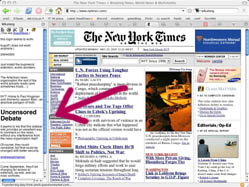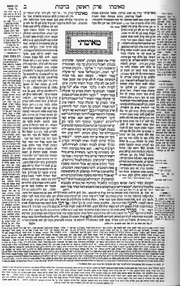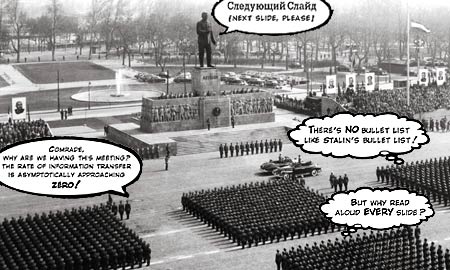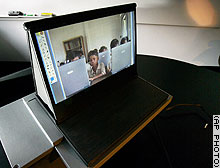Bob’s post last week about changing patterns of media consumption kicked off an interesting discussion, one that leads up perfectly to the “Transliteracies” conference we are attending this weekend at UC Santa Barbara.
Alan Liu, director of the Transliteracies project, posted this response, which very elegantly lays out some of the important questions. He’s allowed me to re-post it here..
BEGIN: The relationship between “browsing” and the “sheer volume” of information is complicated. To start with, I think there is much to be gained in complicating our usually uniform concepts of “browsing” (all shallow, fragmented, attention-deficient) and “volume” (“sheer,” as in a towering, monolithic cliff).
We get a sense of the hidden complexity I indicate if we think historically. Below is a passage from Roger Chartier — the leading scholar in the “history of the book” field — that should give us pause about making any quick associations between browsing and today’s information glut:
“Does this reaction toward the end of the [18th] century indicate a consciousness that reading styles had changed, that the elites in western Europe had passed from intensive and reverent reading to a more extensive, nonchalant reading style, and that such a change called for correction? . . . In the older style: (1) Readers had the choice of only a few books, which perpetuated texts of great longevity. (2) Reading was not separated from other cultural activities such as listening to books read aloud time and again in the bosom of the family, the memorization of such texts . . . , or the recitation of texts read aloud and learned by heart. (3) The relation of reader to book was marked by a weighty respect and charged with a strong sense of the sacred character of printed matter. (4) The intense reading and rereading of the same texts shaped minds that were habituated to a particular set of references and inhabited by the same quotations. It was not until the second half of the eighteen century in Germany and the beginning of the nineteenth century in New England that this style of reading yielded to another style, based on the proliferation of accessible books, on the individualization of the act of reading, on its separation from other cultural activities, and on the descralization of the book. Book reading habits became freer, enabling the reader to pass from one text to another and to have a less attentive attitude toward the printed word, which was less concentrated in a few privileged books.” — Roger Chartier, “Urban Reading Practices, 1660-1770,” in his The Cultural Uses of Print in Early Modern France, trans. Lydia G. Cochrane (Princeton: Princeton Univ. Press, 1987), pp. 222-24
It’s pretty certain that browsing in the face of sheer volume were deep habits of literacy (specifically, of high print literacy). By contrast, one might ask: who read so intensely and deeply — to instance the extreme — that they only really read one book? There were probably just three classes of such people: the very poor (I remembe r, but can’t find at present, an essay by Chartier about people in the past who owned just one book, which was found on their body after a coach accident in Paris), the extremely pious (who read the Bible), or the “genius” author. (Think of Blake, for example: no matter how many books he read, he really only had one or two books on his mental bookshelf: the Bible and Milton.) By contrast, everyone else browsed.
Mass literacy in the twentieth century, perhaps, may be a phenomenon of browsing. Think of Reader’s Digest. After my family immigrated to the U.S. in my childhood, we were a kind of microcosm of assimilation (into English literacy) in this regard. There were two major investments in books in my household: the Reader’s Digest series of condensed books (a kind of packaged browsing) and The World Book encyclopedia (a veritable lesson in reading as browsing-cum-volume). I drank deeply from both founts as a child, since these were the main books in the house. I was intense in my browsing.
So now let’s snap back to the present and the act of browsing cyber- or multi-media volumes of information. I’ve started a project (combining humanists, social scientists, and computer scientists) called Transliteracies to look into “online reading.” It’s my hypothesis that there are hidden complexities and intelligences in low-attention modes of browsing/surfing that we don’t yet know how to chart. Google, after all, is making a fortune for algorithms enacting this hypothesis. Or to cite a historical googler: Dr. Johnson, sage of the Age of Reason, was famous for “devouring” books just by browsing them instead of reading “cover to cover.” (To allude to the titles of the two serial magazines he was involved with, he would have called browsing Rambling or Idling [The Rambler, The Idler.)
Just as “browsing” is complex, so I think that there are hidden complexities in the notion of “sheer volume.” Some of the digital artists I know — e.g., George Legrady, Pockets Full of Memories — are “database artists” whose work asks the question, in essence: what happens to the notion of art when we gaze not at one work in rapt wonder but several thousand works — when, in other words, the “work” is “volume”? What if quantity, in other words, was a matter of quality? Aren’t there different kinds of “volume,” some more intelligent, beautiful, kinder, humane (not to mention efficient and flexible, the usual postindustrial desiderata) than others?
I’d better stop, since this comment is too long. As Blake said about volume: “Enough! or too much.”
 Two books on my bookshelf: the first, a Penguin paperback of The Recognitions by William Gaddis, the spine reinforced with tape, almost every one of the 976 pages covered with annotations in several different colors of ink, some pages torn, many dogeared, some obvious coffee stains. It’s a survivor of a misbegotten thesis project. The second, an old copy of Grace Metalious’s soapy Peyton Place which I found on 6th Avenue two years ago & read cover to cover over the course of six delirious hours when I had taken more DayQuil than I should have. It’s a cheap paperback from the late 1950s, and its yellow pages have clearly passed through any number of hands, but they’re almost entirely unmarked. (God only knows why I decided that I needed to read Peyton Place. I can’t recommend it.)
Two books on my bookshelf: the first, a Penguin paperback of The Recognitions by William Gaddis, the spine reinforced with tape, almost every one of the 976 pages covered with annotations in several different colors of ink, some pages torn, many dogeared, some obvious coffee stains. It’s a survivor of a misbegotten thesis project. The second, an old copy of Grace Metalious’s soapy Peyton Place which I found on 6th Avenue two years ago & read cover to cover over the course of six delirious hours when I had taken more DayQuil than I should have. It’s a cheap paperback from the late 1950s, and its yellow pages have clearly passed through any number of hands, but they’re almost entirely unmarked. (God only knows why I decided that I needed to read Peyton Place. I can’t recommend it.) One of the themes that arose in the first session of Transliteracies was that there are several different types of reading. When academics talk about reading, they tend to mean an intensive activity; there’s typically a lot of writing involved. A great deal of reading, however, isn’t anywhere near as intensive: like my copy of Peyton Place, the text escapes unmarked by the pen. When we talk about moving reading from the printed page to the screen, this is an important consideration: the screen needs to accommodate both of these. Why can’t we curl up with an electronic book? has been a persistent question since electronic reading became a possibility, but it misses the important point that we don’t want to curl up with every book we read. We can only curl up with something if we’re reading it – to some degree – passively.
One of the themes that arose in the first session of Transliteracies was that there are several different types of reading. When academics talk about reading, they tend to mean an intensive activity; there’s typically a lot of writing involved. A great deal of reading, however, isn’t anywhere near as intensive: like my copy of Peyton Place, the text escapes unmarked by the pen. When we talk about moving reading from the printed page to the screen, this is an important consideration: the screen needs to accommodate both of these. Why can’t we curl up with an electronic book? has been a persistent question since electronic reading became a possibility, but it misses the important point that we don’t want to curl up with every book we read. We can only curl up with something if we’re reading it – to some degree – passively.
 About a week ago, I attended a fascinating workshop at USC on
About a week ago, I attended a fascinating workshop at USC on  Sparks fly between juxtaposed texts. While hyperlinks enable the reader to leap between textual worlds, they suck you down a wormhole to a distant place. Sometimes it’s better to be in both spaces at the same time (like keeping two browser windows open at once). Think of the Talmud, the great Jewish compendium of law and exegesis. On each page, commentaries are arrayed around a core text. Wikalong may seem insignificant next to this ancient hypertext system, but it points to a related sort of spatial intertextuality that should theoretically be possible in the new medium. If a flat page can be so multi-dimensional, think of how far we might be able to go in a virtual space.
Sparks fly between juxtaposed texts. While hyperlinks enable the reader to leap between textual worlds, they suck you down a wormhole to a distant place. Sometimes it’s better to be in both spaces at the same time (like keeping two browser windows open at once). Think of the Talmud, the great Jewish compendium of law and exegesis. On each page, commentaries are arrayed around a core text. Wikalong may seem insignificant next to this ancient hypertext system, but it points to a related sort of spatial intertextuality that should theoretically be possible in the new medium. If a flat page can be so multi-dimensional, think of how far we might be able to go in a virtual space.
 Even before the head of the University of Nebraska library began bemoaning how the pictures had fallen out of their collection of vintage agronomy ebooks, the
Even before the head of the University of Nebraska library began bemoaning how the pictures had fallen out of their collection of vintage agronomy ebooks, the 
